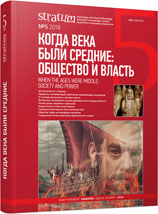Социальный состав владельцев древнерусских кладов (IX—XIII вв.)
Social Composition of the Owners of the Hoards from Old Rus (9th—13th centuries)
Author(s): Natalia V. ZhilinaSubject(s): History, Archaeology, Middle Ages, 6th to 12th Centuries
Published by: Издательский дом Stratum, Университет «Высшая антропологическая школа»
Keywords: Old Rus; Middle Ages; social groups; hoards; adornments; wealth; technology; import;
Summary/Abstract: The author addresses social composition of owners of the early Russian hoards (9th — the first third of 13th centuries), by the following three criteria: material wealth, complexity of techniques of jewelry making, presence or absence of foreign jewelry. As a result, each chronological period was characterized by distinctive types and groups of hoards, associated with different social strata.For the 9th century, most of the hoards are associated with the Slavic nobility. For the 10th century, two main strata of the Russian druzhina of Slavic and Scandinavian origin are distinguished. In the 11th century, the main previously distinguished groups were preserved, but hoards with traditional adornments, mainly associated with the boyars, prevailed. The hoards of the 12th — the first third of the 13th centuries demonstrate a virtually complete social section of society: grand princes, princes and boyars, prince’s servants and representatives of city administration, wealthy urban and rural population.Continuity in the types of hoards over time allows us to corroborate the local roots of the Russian nobility and identify some aristocracy of Scandinavian origin. Changes in the predominant types of hoards show increasing prestige of fine jewelry, among which the share of Russian products was steadily growing.
Journal: Stratum plus. Археология и культурная антропология
- Issue Year: 2018
- Issue No: 5
- Page Range: 251-266
- Page Count: 16
- Language: Russian
- Content File-PDF

